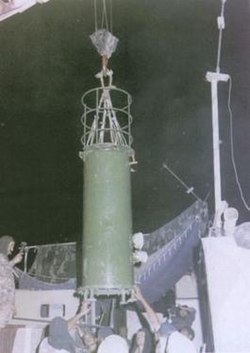Pokhran-II
|
Pokhran-II Operation Shakti |
|
|---|---|

A cylindrical shaped nuclear bomb, Shakti I, prior to its detonation.
|
|
| Information | |
| Country | India |
| Test site | Pokhran Test Range, Rajasthan |
| Period | 11–13 May 1998 |
| Number of tests | 5 |
| Test type | Underground tests |
| Device type | Fission/fusion |
| Max. yield | 43–45 kilotons of TNT (180–190 TJ) tested |
| Navigation | |
| Previous test | Pokhran-I (Operation Smiling Buddha) |
Pokhran-II was the series of five nuclear bomb test explosions conducted by India at the Indian Army's Pokhran Test Range in May 1998. It was the second Indian nuclear test; the first test, code-named Smiling Buddha, was conducted in May 1974.
Pokhran-II consisted of five detonations, of which the first was a fusion bomb and the remaining four were fission bombs. These nuclear tests resulted in a variety of sanctions against India by a number of major states, including Japan and the United States.
On 11 May 1998, Operation Shakti (Pokhran-II) was initiated with the detonation of one fusion and two fission bombs; the word "Shakti" (Devanagari: शक्ति) means "power" in Sanskrit. On 13 May 1998, two additional fission devices were detonated, and the Indian government led by Prime Minister Atal Bihari Vajpayee shortly convened a press conference to declare India a full-fledged nuclear state.
Many names are attributed to these tests; originally they were called Operation Shakti–98 (Power–98), and the five nuclear bombs were designated Shakti-I through Shakti-V. More recently, the operation as a whole has come to be known as Pokhran II, and the 1974 explosion as Pokhran-I.
Efforts towards building the nuclear bomb, infrastructure, and research on related technologies has been undertaken by India since World War II. Origins of India's nuclear program dates back to 1944 when nuclear physicist Homi Bhabha began persuading the Indian Congress towards harnessing of the nuclear energy— a year later he established the Tata Institute of Fundamental Research (TIFR).
...
Wikipedia
